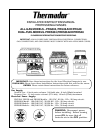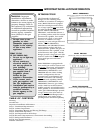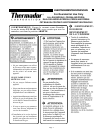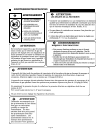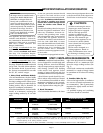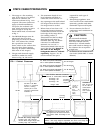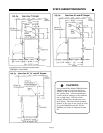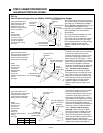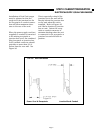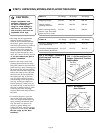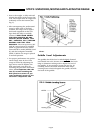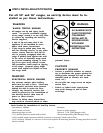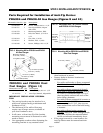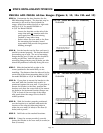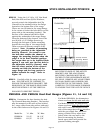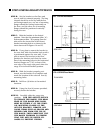
IMPORTANT INSTALLATION INFORMATION
Notes: * For wall installations where adequate space is available, the installer or user may elect to use a hood that is wider than the range
cooking surface. This may be particularly beneficial for those cases, such as a long duct run or heavy usage of the grill, in which
improved capturing of the cooking exhaust is desired.
** Thermador offers a choice of remote (VTR1000Q or VTR1400q) or in-hood (VTN1000Q) blowers for use in wall installations.
VTR1000Q, VTR1400Q
or VTN 1000Q
VTR1000Q, VTR1400Q
or VTN 1000Q
VTR1000Q, VTR1400Q
or VTN 1000Q
30" RANGE
36" RANGE
48" RANGE
PHI48QS
PHI48QS
PHI60QS
VTR1400Q
VTR1400Q
VTR1400Q
PH30HQS
PHE30,36
PH36HQS
PHE36,42
PH48HQS
PHE48,60
WALL INSTALLATION ISLAND INSTALLATION
RANGE WIDTH
HOOD* BLOWER** HOOD BLOWER
It is strongly recommended that a suit-
able exhaust hood be installed above
the range. Downdraft ventilation should
not be used. The table below indicates
the Thermador hoods, by model num-
ber, that are recommended for use with
the 30", 36", and 48" ranges.
1. Select Hood and Blower Models:
• For wall installations, the hood width
must, at a minimum, equal the width of
the range cooking surface. Where space
permits, a hood larger in width than the
cooking surface may be desirable for
improved ventilation performance.
• For island installations, the hood width
should, at a minimum, overhang the
range cooking surface by 6" on both
sides.
CAUTION: Ventilation hoods and blow-
ers are designed for use with single wall
ducting. However, some local building
codes or inspectors may require double
wall ducting. Consult local building
codes and/or local agencies, before
starting, to assure that hood and duct
installation will meet local requirements.
• Hood blower speeds should be vari-
able to reduce noise and loss of heated
or air conditioned household air when
maximum ventilation is not required.
Normally, the maximum blower speed
is only required when using the grill.
2. Hood Placement:
• For best smoke elimination, the lower
edge of the hood should be installed a
minimum of 30" to a maximum of 36"
above the range cooking surface. (See
Fig. 1).
• If the hood contains any combustible
materials (i.e. a wood covering), it must
be a minimum of 42" above the cooking
surface.
3. Consider Make-Up Air:
• Due to the high volume of ventilation
air, a source of outside replacement air
is recommended. This is particularly
important for tightly sealed and insu-
lated homes.
• A qualified heating and ventilating
contractor should be consulted.
STEP 1: VENTILATION REQUIREMENTS
mittent/interrupted ignition device that
cycles the two far left surface burners on
and off when in the ExtraLow
®
setting.
I
MPORTANT:
All ranges must be installed with a
backguard. Models PRG304 and
PRDS304 are shipped from the
factory with a standard 9" back-
guard. For all other models one of
three available backguards must be
ordered separately and installed at
the back of the range. The three
backguard choices include a Low
Back Guard, High Shelf, or Island
Trim. See STEPS 2 and 6.
of this unit, particular attention should
be paid to the hood and duct work
installation to assure it meets local build-
ing codes. To eliminate risk of burns or
fire caused by reaching over heated
surface units, cabinet storage located
above the surface units should be
avoided.
Check local building codes for the proper
method of appliance installation. Local
codes vary. Installation, electrical con-
nections and grounding must comply
with all applicable codes. In the absence
of local codes the appliance should be
installed in accordance with the National
Fuel Gas Code ANSI Z223.1 Current
Issue and National Electrical Code ANSI/
NFPA 70-Current Issue. In Canada, in-
stallation must be in accordance with
the CAN 1-B149.1 and .2 – Installation
Codes for Gas Burning Appliances and/
or local codes.
This appliance is equipped with an inter-
This appliance has been tested in ac-
cordance with ANSI Z21.1 Current Is-
sue, Standard for Household Cooking
Appliances (USA) and in accordance
with CAN 1.1-M81 Domestic Gas
Ranges (CANADIAN).
It is strongly recommended that this
appliance be installed in conjunction
with a suitable overhead vent hood.
(See Step 1 for Ventilation Require-
ments.) Due to the high heat capability
CAUTION:
(1) When connecting the unit to
propane gas, make certain the
propane gas tank is equipped
with its own high pressure
regulator in addition to the
pressure regulator supplied with
this unit. The maximum gas
pressure to this appliance is not
to exceed 14.0 inches (37mb)
water column from the propane
gas tank regulator.
(2) This unit is designed as a
cooking appliance. Based on
safety considerations never use it
for warming or heating a room.
Page 3



